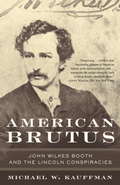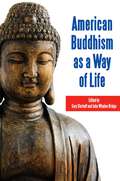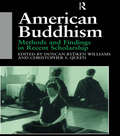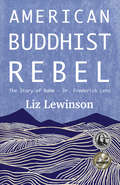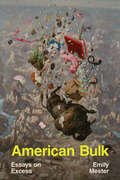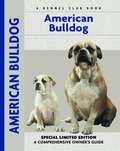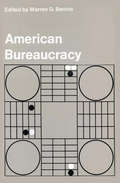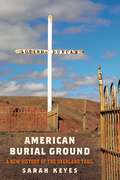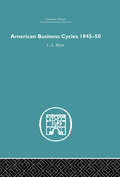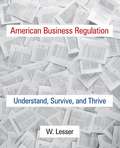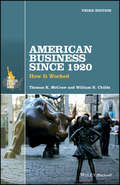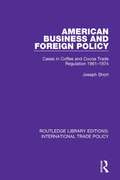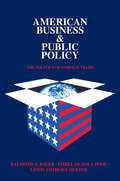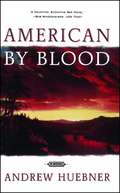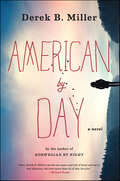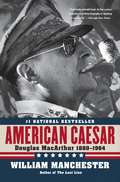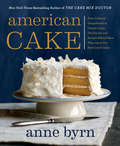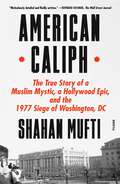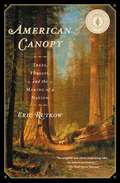- Table View
- List View
American Brutus
by Michael W. KauffmanIt is a tale as familiar as our history primers: A deranged actor, John Wilkes Booth, killed Abraham Lincoln in Ford's Theatre, escaped on foot, and eluded capture for twelve days until he met his fiery end in a Virginia tobacco barn. In the national hysteria that followed, eight others were arrested and tried; four of those were executed, four imprisoned. Therein lie all the classic elements of a great thriller. But the untold tale is even more fascinating.Now, in American Brutus, Michael W. Kauffman, one of the foremost Lincoln assassination authorities, takes familiar history to a deeper level, offering an unprecedented, authoritative account of the Lincoln murder conspiracy. Working from a staggering array of archival sources and new research, Kauffman sheds new light on the background and motives of John Wilkes Booth, the mechanics of his plot to topple the Union government, and the trials and fates of the conspirators.Piece by piece, Kauffman explains and corrects common misperceptions and analyzes the political motivation behind Booth's plan to unseat Lincoln, in whom the assassin saw a treacherous autocrat, "an American Caesar." In preparing his study, Kauffman spared no effort getting at the truth: He even lived in Booth's house, and re-created key parts of Booth's escape. Thanks to Kauffman's discoveries, readers will have a new understanding of this defining event in our nation's history, and they will come to see how public sentiment about Booth at the time of the assassination and ever since has made an accurate account of his actions and motives next to impossible-until now.In nearly 140 years there has been an overwhelming body of literature on the Lincoln assassination, much of it incomplete and oftentimes contradictory. In American Brutus, Kauffman finally makes sense of an incident whose causes and effects reverberate to this day. Provocative, absorbing, utterly cogent, at times controversial, this will become the definitive text on a watershed event in American history.From the Hardcover edition.
American Brutus
by Michael W. KauffmanIt is a tale as familiar as our history primers: A deranged actor, John Wilkes Booth, killed Abraham Lincoln in Ford's Theatre, escaped on foot, and eluded capture for twelve days until he met his fiery end in a Virginia tobacco barn. In the national hysteria that followed, eight others were arrested and tried; four of those were executed, four imprisoned. Therein lie all the classic elements of a great thriller. But the untold tale is even more fascinating.Now, in American Brutus, Michael W. Kauffman, one of the foremost Lincoln assassination authorities, takes familiar history to a deeper level, offering an unprecedented, authoritative account of the Lincoln murder conspiracy. Working from a staggering array of archival sources and new research, Kauffman sheds new light on the background and motives of John Wilkes Booth, the mechanics of his plot to topple the Union government, and the trials and fates of the conspirators.Piece by piece, Kauffman explains and corrects common misperceptions and analyzes the political motivation behind Booth's plan to unseat Lincoln, in whom the assassin saw a treacherous autocrat, "an American Caesar." In preparing his study, Kauffman spared no effort getting at the truth: He even lived in Booth's house, and re-created key parts of Booth's escape. Thanks to Kauffman's discoveries, readers will have a new understanding of this defining event in our nation's history, and they will come to see how public sentiment about Booth at the time of the assassination and ever since has made an accurate account of his actions and motives next to impossible-until now.In nearly 140 years there has been an overwhelming body of literature on the Lincoln assassination, much of it incomplete and oftentimes contradictory. In American Brutus, Kauffman finally makes sense of an incident whose causes and effects reverberate to this day. Provocative, absorbing, utterly cogent, at times controversial, this will become the definitive text on a watershed event in American history.From the Hardcover edition.
American Brutus: John Wilkes Booth and the Lincoln Conspiracies
by Michael W. KauffmanIt is a tale as familiar as our history primers: A deranged actor, John Wilkes Booth, killed Abraham Lincoln in Ford's Theatre, escaped on foot, and eluded capture for twelve days until he met his fiery end in a Virginia tobacco barn. In the national hysteria that followed, eight others were arrested and tried; four of those were executed, four imprisoned. Therein lie all the classic elements of a great thriller. But the untold tale is even more fascinating. Now, in American Brutus, Michael W. Kauffman, one of the foremost Lincoln assassination authorities, takes familiar history to a deeper level, offering an unprecedented, authoritative account of the Lincoln murder conspiracy. Working from a staggering array of archival sources and new research, Kauffman sheds new light on the background and motives of John Wilkes Booth, the mechanics of his plot to topple the Union government, and the trials and fates of the conspirators. Piece by piece, Kauffman explains and corrects common misperceptions and analyzes the political motivation behind Booth's plan to unseat Lincoln, in whom the assassin saw a treacherous autocrat, "an American Caesar. " In preparing his study, Kauffman spared no effort getting at the truth: He even lived in Booth's house, and re-created key parts of Booth's escape. Thanks to Kauffman's discoveries, readers will have a new understanding of this defining event in our nation's history, and they will come to see how public sentiment about Booth at the time of the assassination and ever since has made an accurate account of his actions and motives next to impossible-until now. In nearly 140 years there has been an overwhelming body of literature on the Lincoln assassination, much of it incomplete and oftentimes contradictory. In American Brutus, Kauffman finally makes sense of an incident whose causes and effects reverberate to this day. Provocative, absorbing, utterly cogent, at times controversial, this will become the definitive text on a watershed event in American history. From the Hardcover edition.
American Buddhism as a Way of Life (SUNY series in Buddhism and American Culture)
by John Whalen-Bridge Gary StorhoffThe US seems to be becoming a Buddhist country. Celebrity converts, the popularity of the Dalai Lama, motifs in popular movies, and mala beads at the mall indicate an increasing inculcation of Buddhism into the American consciousness, even if a relatively small percentage of the population actually describe themselves as Buddhists. This book looks beyond the trendier manifestations of Buddhism in America to look at distinctly American Buddhist ways of life—ways of perceiving and understanding. John Whalen-Bridge and Gary Storhoff have organized this unique collection in accordance with the Buddhist concept of the Three Jewels: the Buddha, the Dharma, and the Sangha. The Buddha section discusses the two key teachers who popularized Buddhism in America: Alan Watts and D. T. Suzuki and the particular kinds of spirituality they proclaimed. The Dharma section deals with how Buddhism can enlighten current public debates and a consideration of our national past with explorations of bioethics, abortion, end-of-life decisions, and consciousness in late capitalism. The final section on the Sangha, or community of believers, discusses how Buddhist communities both formal and informal have affected American society with chapters on family life, Nisei Buddhists, gay liberation, and Zen gardens.
American Buddhism: Methods and Findings in Recent Scholarship (Routledge Critical Studies in Buddhism)
by Duncan Ryuken Williams Christopher QueenThis is the first scholarly treatment of the emergence of American Buddhist Studies as a significant research field. Until now, few investigators have turned their attention to the interpretive challenge posed by the presence of all the traditional lineages of Asian Buddhism in a consciously multicultural society. Nor have scholars considered the place of their own contributions as writers, teachers, and practising Buddhists in this unfolding saga. In thirteen chapters and a critical introduction to the field, the book treats issues such as Asian American Buddhist identity, the new Buddhism, Buddhism and American culture, and the scholar's place in American Buddhist Studies. The volume offers complete lists of dissertations and theses on American Buddhism and North American dissertations and theses on topics related to Buddhism since 1892.
American Buddhist Rebel: The Story of Rama - Dr. Frederick Lenz
by Liz LewinsonWinner of the 2016 Eric Hoffer Award, this acclaimed biography of the brilliant, controversial Buddhist teacher Rama - Dr. Frederick Lenz (1950 - 1998) is this free-spirited adventure of a wild, sports jock teenager who transforms into an iconoclastic, innovative leader, boundary breaking is de rigueur as reported by the 100+ students and colleagues interviewed by author Liz Lewinson. Meditation, the empowerment of women and career as practice are but three of the core teachings covered in this book. Dr. Lenz ran into opposition, of course, but he kept his priorities straight. When he visited Nepal at age 19, he encountered an aged monk who informed him that he was a lineage bearer. He was to revive an ancient school of enlightenment. He was to find his many past life students and help them achieve joyous enlightenment in this life or at least set them securely on the path. He was to do this in the West, using Western means. In the East, centuries-old traditions maintain meditative pathways to enlightenment. In the West, facing a blank canvas, Dr. Lenz found new ways to build mental/meditative prowess through careers such as computer science, visits to American "places of power," knowledge about real gender equilibrium, movies, music, and dance. He taught these skills to American students and observed their success. When you read this fast-paced biography, you enter the inner teaching circle of baseline American Buddhism. "This fascinating biography captures the wisdom of a genuine, compelling teacher who combined absolute miracles with humor, fun, and adventure. When you read this fast-paced book, you feel you are there, learning and transforming. This is an original and exciting read." -- Lynn Andrews, author of The Medicine Woman Series
American Buffalo: In Search of a Lost Icon
by Steven RinellaA hunt for the American buffalo—an adventurous, fascinating examination of an animal that has haunted the American imagination. In 2005, Steven Rinella won a lottery permit to hunt for a wild buffalo, or American bison, in the Alaskan wilderness. Despite the odds—there’s only a 2 percent chance of drawing the permit, and fewer than 20 percent of those hunters are successful—Rinella managed to kill a buffalo on a snow-covered mountainside and then raft the meat back to civilization while being trailed by grizzly bears and suffering from hypothermia. Throughout these adventures, Rinella found himself contemplating his own place among the 14,000 years’ worth of buffalo hunters in North America, as well as the buffalo’s place in the American experience. At the time of the Revolutionary War, North America was home to approximately 40 million buffalo, the largest herd of big mammals on the planet, but by the mid-1890s only a few hundred remained. Now that the buffalo is on the verge of a dramatic ecological recovery across the West, Americans are faced with the challenge of how, and if, we can dare to share our land with a beast that is the embodiment of the American wilderness. American Buffalois a narrative tale of Rinella’s hunt. But beyond that, it is the story of the many ways in which the buffalo has shaped our national identity. Rinella takes us across the continent in search of the buffalo’s past, present, and future: to the Bering Land Bridge, where scientists search for buffalo bones amid artifacts of the New World’s earliest human inhabitants; to buffalo jumps where Native Americans once ran buffalo over cliffs by the thousands; to the Detroit Carbon works, a “bone charcoal” plant that made fortunes in the late 1800s by turning millions of tons of buffalo bones into bone meal, black dye, and fine china; and even to an abattoir turned fashion mecca in Manhattan’s Meatpacking District, where a depressed buffalo named Black Diamond met his fate after serving as the model for the American nickel. Rinella’s erudition and exuberance, combined with his gift for storytelling, make him the perfect guide for a book that combines outdoor adventure with a quirky blend of facts and observations about history, biology, and the natural world. Both a captivating narrative and a book of environmental and historical significance,American Buffalotells us as much about ourselves as Americans as it does about the creature who perhaps best of all embodies the American ethos.
American Bulk: Essays on Excess
by Emily MesterRaised with hoarding and compulsive shopping, Emily Mester is caught in between. What happens when consumption begins to consume you back? In a series of deeply personal essays, Mester explores how the things we buy, eat, amass, and discard become an intimate part of our lives. We guiltily watch Amazon boxes pile up on the porch, wade through endless reviews to find the perfect product, and crave the comforting indulgence of a chain restaurant. With humor and sharp intellect, Mester reflects on the joys and anxieties of Costco trips, how a seasonal stint at Ulta Beauty taught her the insidious art of the sale, and what it means to get “mall sad.” In a nuanced examination of diet culture and fatness, Mester recounts her teenage summer at fat camp and the unexpected liberation she finds there. Finally, she ventures to Storm Lake, Iowa, to reckon with her grandmother’s abandoned hoard, excavating the dysfunction that lies at the heart of her family’s obsession with stuff. American Bulk introduces readers to a striking new literary talent from the American heartland, one who dares to ask us to regard consumption not with guilt but with grace and empathy.
American Bulldog
by Wil Deveer Abe FishmanOnce a well-kept secret in the United States, the American Bulldog is now one of the nation's most celebrated canine exports, establishing a devoted following around the globe. This Comprehensive Owner's Guide is dedicated to the American Bulldog, a breed that was once used as a ranch and farm dog but today excels as a companion and protection dog. Author Abe Fishman provides a controversial but wholly candid retelling of the breed's history and its re-creation in the United States. The history chapter is followed by a chapter devoted to the characteristics of this exceptional working breed, offering sound advice about which owners are best suited to this vigorous and active canine.New owners will welcome the well-prepared chapter on finding a reputable breeder and selecting a healthy, sound puppy. Chapters on puppy-proofing the home and yard, purchasing the right supplies for the puppy as well as house-training, feeding, and grooming are illustrated with photographs of handsome adults and puppies. In all, there are over 135 full-color photographs in this useful and reliable volume. The author's advice on obedience training will help the reader better mold and train into the most well-mannered dog in the neighborhood. The extensive and lavishly illustrated chapter on healthcare provides up-to-date detailed information on selecting a qualified veterinarian, vaccinations, preventing and dealing with parasites, infectious diseases, and more. Sidebars throughout the text offer helpful hints, covering topics as diverse as historical dogs, breeders, or kennels, toxic plants, first aid, crate training, carsickness, fussy eaters, and parasite control. Fully indexed. .
American Bureaucracy
by Warren G BennisLike it or not, contemporary man is man-in-bureaucracy. He spends the majority of his waking hours in a bureaucracy; establishes an identity and status in a bureaucracy; garners most of his satisfactions and disappointments in a bureaucracy; and, increasingly, he is what he does.Aside from the importance of understanding those institutions that shape our values, behavior, and experience, bureaucracy is a vital area for study because it reveals a wide range of social behavior in a compact and comprehensible way. The abstract and ephemeral problems of society at large are brought down to earth —made measurable, comprehensible and visible in the bureaucratic microcosm. Problems of power and influence, change and innovation, intergroup conflict, ambition and aspiration, self-realization versus participative democracy, technology versus humanism: all can be observed and analyzed in human organizations.This volume pinpoints the dilemma of present bureaucratic organizations: the conflict between the need to sustain innovation and bureaucratic drives toward rationality and stability. The essays it contains discuss specific human needs that bureaucracy must meet if it is to continue to attract talented people and takes a step into the future to analyze the kinds of organizations that may be expected to evolve as institutions seek more flexible use of human resources.
American Burial Ground: A New History of the Overland Trail (America in the Nineteenth Century)
by Sarah KeyesIn popular mythology, the Overland Trail is typically a triumphant tale, with plucky easterners crossing the Plains in caravans of covered wagons. But not everyone reached Oregon and California. Some 6,600 migrants perished along the way and were buried where they fell, often on Indigenous land. As historian Sarah Keyes illuminates, their graves ultimately became the seeds of U.S. expansion.By the 1850s, cholera epidemics, ordinary diseases, and violence had remade the Trail into an American burial ground that imbued migrant deaths with symbolic power. In subsequent decades, U.S. officials and citizens leveraged Trail graves to claim Native ground. Meanwhile, Indigenous peoples pointed to their own sacred burial grounds to dispute these same claims and maintain their land. These efforts built on anti-removal campaigns of the 1820s and 30s, which had established the link between death and territorial claims on which the significance of the Overland Trail came to rest.In placing death at the center of the history of the Overland Trail, American Burial Ground offers a sweeping and long overdue reinterpretation of this historic touchstone. In this telling, westward migration was a harrowing journey weighed down by the demands of caring for the sick and dying. From a tale of triumph comes one of struggle, defined as much by Indigenous peoples’ actions as it was by white expansion. And, finally, from a migration to the Pacific emerges instead a trail of graves. Graves that ultimately undergirded Native dispossession.
American Business Cycles 1945-50
by Conrad BlythAfter the end of the Second World War businessmen and economists throughout the world feared that the American postwar inflationary boom would end in a serious slump. The slump took a long time to come, and when it did appear in 1949 it was both mild and short lived. In its mildness and brevity it foreshadowed the American business recessions since that time and, indeed, may foreshadow the end of the business cycle as it has been known in the past. This book presents the first full-scale study of the 1948–49 recession in the United States, making it the focal point of a detailed, analytical account of American business fluctuations from the end of the Second World War until the beginning of the Korean War. The main part of the book is prefaced by a review of fluctuations from 1945 to 1967 and of the business cycle theory, which places the postwar events in perspective. Of special importance are the studies of the ending, in early 1948, of the period of re-stocking and re-equipment; of the impact of the changed farm situation in this deflationary atmosphere, and use of modern consumption theory to explain the changes in household spending after the war and during the recession. Dr. Blyth has drawn extensively upon the results of modern economic research, and has woven the econometric findings and the historical narrative together with a theoretical analysis. He conclusively rejects the theory that recent U.S. business cycles are the result of any largely self-perpetuating fluctuation in investment in stocks. Instead he draws attention to the persistent destabilizing roles of changes in defense expenditure and of changes in monetary policy-inventory investment performs the largely passive role of aggravating these changes. The book, first published in 1969, will be of value not only to specialists in business cycle studies, but to economists and others concerned with the problems of stability and growth in the international economy, as well as to economic historians.
American Business Regulation: Understand, Survive and Thrive
by William LesserWhile there are lengthy texts discussing the economics of why and how governments regulate business and apply antitrust, this book is unique in providing the details of current business regulation in many industries through lengthy examples the author develops with the use of cases, including Harvard Business School cases. Students are then guided to devise business strategies of introducing new products within the scope of regulation (known or unknown). While the economic theories of regulation are covered, the focus of this text is a "hands-on coping" with regulation and using regulation as a business strategy to deal with competitors. Online instructor's materials are also available for adopters.
American Business Since 1920: How It Worked (The American History Series #29)
by Thomas K. McCraw William R. ChildsTells the story of how America’s biggest companies began, operated, and prospered post-World War I This book takes the vantage point of people working within companies as they responded to constant change created by consumers and technology. It focuses on the entrepreneur, the firm, and the industry, by showing—from the inside—how businesses operated after 1920, while offering a good deal of Modern American social and cultural history. The case studies and contextual chapters provide an in-depth understanding of the evolution of American management over nearly 100 years. American Business Since 1920: How It Worked presents historical struggles with decision making and the trend towards relative decentralization through stories of extraordinarily capable entrepreneurs and the organizations they led. It covers: Henry Ford and his competitor Alfred Sloan at General Motors during the 1920s; Neil McElroy at Procter & Gamble in the 1930s; Ferdinand Eberstadt at the government’s Controlled Materials Plan during World War II; David Sarnoff at RCA in the 1950s and 1960s; and Ray Kroc and his McDonald’s franchises in the late twentieth century and early twenty-first; and more. It also delves into such modern success stories as Amazon.com, eBay, and Google. Provides deep analysis of some of the most successful companies of the 20th century Contains topical chapters covering titans of the 2000s Part of Wiley-Blackwell’s highly praised American History Series American Business Since 1920: How It Worked is designed for use in both basic and advanced courses in American history, at the undergraduate and graduate levels.
American Business and Foreign Policy: Cases in Coffee and Cocoa Trade Regulation 1961-1974 (Routledge Library Editions: International Trade Policy #1)
by Joseph ShortDeveloping countries have for many decades waged a campaign for the global regulation of trade in primary products through international commodity agreements. Heavily dependent upon exports of primary products, developing countries hope to regulate the markets for their commodities to achieve higher prices. While there is a myriad of obstacles to agreements, the blame for slow progress is often laid at the feet of the industrial, commodity-consuming countries, particularly the US. This book, first published in 1987, is a comparative case study that closely analyses how American businesses behaved in relation to US government responses to developing countries’ demands for commodity agreements for coffee and cocoa.
American Business and Public Policy: The politics of foreign trade
by Theodore DraperAmerican Business and Public Policy is a study of the politics of foreign trade. It challenges fifty years of writ-ing on pressure politics. It includes nine hundred interviews with heads of corporations, including 166 of the 200 largest corporations; another 500 interviews with congressmen, lob-byists, journalists, and opinion leaders; and eight community studies making this book the most intensive survey in print of the politics of business. It is a realistic behavioral examination of a major type of economic decision.The authors introduce their study with a history of the tariff as a political issue in American politics and a history of American tariff legislation in the years from Europe's trade recovery under the Marshall Plan to the challenge of the Common Market. They examine in succession the changing attitudes of the general public and the political actions of the business community, the lobbies, and Congress.American Business and Public Policy is a contribution to social theory in several of its branches. It is a contribution to understanding the business community, to the social psychol-ogy of communication and attitude change, to the study of political behavior in foreign policy.American Business and Public Policy is at once a study of a classic issue in American politics the tariff; decision-making, particularly the relation of economic to social-psycho-logical theories of behavior; business communication what businessmen read about world affairs, what effect foreign travel has on them, where they turn for political advice, and how they seek political help; pressure politics, lobbying, and the Congressional process.
American By Blood
by Andrew HuebnerIn American by Blood, three U.S. Army scouts leading an infantry column arrive a day late to join Custer at the Little Bighorn. They come upon the ruins of th Seventh Cavalry, a trail of blood and corpses defiled by wild dogs and swarms of flies. It is a scene that will haunt these three young men in vivid and irrevocable ways. With the loss at Little Bighorn, their mission to find and help clear the land of the Indian tribes ineluctably becomes one of vengeance as well. They journey into limitless wilderness after their prey, skirmishing in the dense forests and the high plains. The scouting party consists of James H. Bradley, who discovers that war is as much a test of the heart as it is of his ideals; William Gentle, who finds himself torn between his desire to emulate the older soldiers and his fascination with the Indians they hunt; and August Huebner, who wishes to see an America beyond that which he knows and escape the slums of the newly industrialized East. Gus Huebner was the author's great-great-grandfather, who in 1875 left New Jersey to join the army int he West. Family myth has it that he arrived a day late to the Battle of Little Bighorn. From these scant biographical details, Andrew Huebner has imagined a rich and powerful novel of the American West. American by Blood unforgettably combines epic storytelling and evocations of awe-inspiring natural beauty with a shattering repudiation of some of our nation's most central myths.
American By Day: A Novel
by Derek B. MillerA gripping and timely novel that follows Sigrid—the dry-witted detective from Derek B. Miller’s best-selling debut Norwegian by Night—from Oslo to the United States on a quest to find her missing brother.She knew it was a weird place. She’d heard the stories, seen the movies, read the books. But now police Chief Inspector Sigrid Ødegård has to leave her native Norway and actually go there; to that land across the Atlantic where her missing brother is implicated in the mysterious death of a prominent African American academic—America.Sigrid is plunged into a United States where race and identity, politics and promise, reverberate in every aspect of daily life. Working with—or, if necessary, against—the police, she must negotiate the local political minefields and navigate the backwoods of the Adirondacks to uncover the truth before events escalate further.Refreshingly funny, slyly perceptive, American by Day is “a superb novel on all levels” (Times, UK).“Ingenious. Humorous. Wonderful.”—Lee Child
American By Degrees
by Robert J. YoungThe expressions of American hostility toward France after 9/11 are not new - Franco-American relations in the early twentieth century were also difficult, characterized by the same antagonistic depictions of the other's culture. Ambassador Jules Jusserand's years in Washington (1903-24) were defined by efforts to correct such misconceptions, whether they came from the venomous pens of French extremists or from members of William Randolph Hearst's press empire. In An American by Degrees Robert Young explores Ambassador Jusserand's life and legacy. Fluent in English, married to an American, and a historian who was a frequent guest at many American universities, Jusserand deftly cultivated American sympathies for France. His tasks as a diplomat were formidable, whether during the period of America's war-time neutrality - when France was nearly over-run by the German army - or when as allies they competed for control of the peace process or sought to resolve post-war issues like disarmament, war debts, and reparations. Jusserand relentlessly reminded Americans that France had been an ally during their Revolution and that their concept of "civilization" was part of France's intellectual and cultural legacy. His emphasis on their shared history was natural, as befitted the first winner of the Pulitzer Prize in History and only the second foreigner to serve as president of the American Historical Association.
American By Degrees: The Extraordinary Lives of French Ambassador Jules Jusserand
by Robert J. YoungThe expressions of American hostility toward France after 9/11 are not new - Franco-American relations in the early twentieth century were also difficult, characterized by the same antagonistic depictions of the other's culture. Ambassador Jules Jusserand's years in Washington (1903-24) were defined by efforts to correct such misconceptions, whether they came from the venomous pens of French extremists or from members of William Randolph Hearst's press empire. In An American by Degrees Robert Young explores Ambassador Jusserand's life and legacy. Fluent in English, married to an American, and a historian who was a frequent guest at many American universities, Jusserand deftly cultivated American sympathies for France. His tasks as a diplomat were formidable, whether during the period of America's war-time neutrality - when France was nearly over-run by the German army - or when as allies they competed for control of the peace process or sought to resolve post-war issues like disarmament, war debts, and reparations. Jusserand relentlessly reminded Americans that France had been an ally during their Revolution and that their concept of "civilization" was part of France's intellectual and cultural legacy. His emphasis on their shared history was natural, as befitted the first winner of the Pulitzer Prize in History and only the second foreigner to serve as president of the American Historical Association.
American Caesar: Douglas MacArthur 1880 - 1964
by William ManchesterInspiring, outrageous... A thundering paradox of a man. Douglas MacArthur, one of only five men in history to have achieved the rank of General of the United States Army. He served in World Wars I, II, and the Korean War, and is famous for stating that "in war, there is no substitute for victory." AMERICAN CAESAR exaines the exemplary army career, the stunning successes (and lapses) on the battlefield, and the turbulent private life of the soldier-hero whose mystery and appeal created a uniquely American legend.
American Cake: From Colonial Gingerbread to Classic Layer, the Stories and Recipes Behind More Than 125 of Our Best-Loved Cakes
by Anne ByrnTaste your way through America with more than 125 recipes for our favorite historical cakes and frostings.Cakes in America aren't just about sugar, flour, and frosting. They have a deep, rich history that developed as our country grew. Cakes, more so than other desserts, are synonymous with celebration and coming together for happy times. They're an icon of American culture, reflecting heritage, region, season, occasion, and era. And they always have been, throughout history.In American Cake, Anne Byrn, creator of the New York Times bestselling series The Cake Mix Doctor, takes you on a journey through America's past to present with more than 125 authentic recipes for our best-loved and beautiful cakes and frostings. Tracing cakes chronologically from the dark, moist gingerbread of New England to the elegant pound cake, the hardscrabble Appalachian stack cake, war cakes, deep-South caramel, Hawaiian Chantilly, and the modern California cakes of orange and olive oil, Byrn shares recipes, stories, and a behind-the-scenes look into what cakes we were baking back in time. From the well-known Angel Food, Red Velvet, Pineapple Upside-Down, Gooey Butter, and Brownie to the lesser-known Burnt Leather, Wacky Cake, Lazy Daisy, and Cold Oven Pound Cake, this is a cookbook for the cook, the traveler, or anyone who loves a good story. And all recipes have been adapted to the modern kitchen.
American Caliph: The True Story of a Muslim Mystic, a Hollywood Epic, and the 1977 Siege of Washington, DC
by Shahan MuftiOne of Publishers Weekly's best nonfiction books of 2022The riveting true story of America’s first homegrown Muslim terror attack, the 1977 Hanafi siege of Washington, D.C. Late in the morning of March 9, 1977, seven men stormed the Washington, D.C., headquarters of B’nai B’rith International, the largest and oldest Jewish service organization in America. The heavily armed attackers quickly took control of the building and held more than a hundred employees of the organization hostage inside. A little over an hour later, three more men entered the Islamic Center of Washington, the country’s largest and most important mosque, and took hostages there. Two others subsequently penetrated the District Building, a few hundred yards from the White House. When a firefight broke out, a reporter was killed, and Marion Barry, later to become mayor of Washington, D.C., was shot in the chest. The deadly standoff brought downtown Washington to a standstill. The attackers belonged to the Hanafi Movement, an African American Muslim group based in D.C. Their leader was a former jazz drummer named Hamaas Abdul Khaalis, who had risen through the ranks of the Nation of Islam before feuding with the organization’s mercurial chief, Elijah Muhammad, and becoming a spiritual authority to Kareem Abdul-Jabbar. Like Malcolm X, Khaalis had become sharply critical of the Nation’s unorthodox style of Islam. And, like Malcolm X, he paid dearly for his outspokenness: In 1973, followers of the Nation murdered seven Hanafis at their headquarters, including several members of Khaalis’s family. When they took hostages in 1977, one of the Hanafis’ demands was for the murderers, along with Muhammad Ali and Elijah’s son, to be turned over to the group to face justice. They also demanded that the American premiere of Mohammad: Messenger of God—an epic about the life of the prophet Muhammad financed and supported by the Libyan leader Muammar Gadhafi—be canceled and the film destroyed. The lives of 149 hostages hung in the balance, and the United States’ fledgling counterterrorism forces—as yet untested—would have to respond. Shahan Mufti’s American Caliph gives a full account of the largest ever hostage taking on American soil and of the man who masterminded it. Informed by extensive archival research and access to hundreds of declassified FBI files, American Caliph is a riveting true-crime story that sheds new light on the disarray of the 1970s and its ongoing reverberations.
American Cancer Society: Access to Care
by Robert L. Simons Kathryn RosenbergCEO John Seffrin decides to radically change the strategy of the American Cancer Society. The new Access to Care strategy relies on advocacy to change public policy and increase the number of Americans eligible for cancer prevention and treatment. The new strategy brings with it considerable political risk. Leveraging an organization with 3 million volunteers, this case describes how he skillfully transforms the organization (structure, control systems, staff, shared values, etc.) to implement the new strategy.
American Canopy: The Role of Trees in the Shaping of a Nation
by Eric RutkowThis fascinating and groundbreaking work tells the remarkable story of the relationship between Americans and their trees across the entire span of our nation's history. Like many of us, historians have long been guilty of taking trees for granted. Yet the history of trees in America is no less remarkable than the history of the United States itself--from the majestic white pines of New England, which were coveted by the British Crown for use as masts in navy warships, to the orange groves of California, which lured settlers west. In fact, without the country's vast forests and the hundreds of tree species they contained, there would have been no ships, docks, railroads, stockyards, wagons, barrels, furniture, newspapers, rifles, or firewood. No shingled villages or whaling vessels in New England. No New York City, Miami, or Chicago. No Johnny Appleseed, Paul Bunyan, or Daniel Boone. No Allied planes in World War I, and no suburban sprawl in the middle of the twentieth century. America--if indeed it existed--would be a very different place without its millions of acres of trees. As Eric Rutkow's brilliant, epic account shows, trees were essential to the early years of the republic and indivisible from the country's rise as both an empire and a civilization. Among American Canopy's many fascinating stories: the Liberty Trees, where colonists gathered to plot rebellion against the British; Henry David Thoreau's famous retreat into the woods; the creation of New York City's Central Park; the great fire of 1871 that killed a thousand people in the lumber town of Peshtigo, Wisconsin; the fevered attempts to save the American chestnut and the American elm from extinction; and the controversy over spotted owls and the old-growth forests they inhabited. Rutkow also explains how trees were of deep interest to such figures as George Washington, Thomas Jefferson, Benjamin Franklin, Teddy Roosevelt, and FDR, who oversaw the planting of more than three billion trees nationally in his time as president. As symbols of liberty, community, and civilization, trees are perhaps the loudest silent figures in our country's history. America started as a nation of people frightened of the deep, seemingly infinite woods; we then grew to rely on our forests for progress and profit; by the end of the twentieth century we came to understand that the globe's climate is dependent on the preservation of trees. Today, few people think about where timber comes from, but most of us share a sense that to destroy trees is to destroy part of ourselves and endanger the future. Never before has anyone treated our country's trees and forests as the subject of a broad historical study, and the result is an accessible, informative, and thoroughly entertaining read. Audacious in its four-hundred-year scope, authoritative in its detail, and elegant in its execution, American Canopy is perfect for history buffs and nature lovers alike and announces Eric Rutkow as a major new author of popular history.
